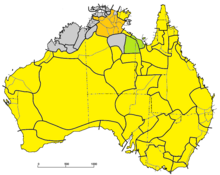Yanyuwa language
| Yanyuwa | |
|---|---|
| Native to | Australia |
| Region | Northern Territory |
|
Native speakers
|
70 (2005) to 130 (2006 census) |
|
Pama–Nyungan
|
|
| Language codes | |
| ISO 639-3 | |
| Glottolog | yany1243 |
| AIATSIS | N153 |

Yanyuwa is the patch of yellow on the northern coast, between the orange and the green.
|
|
Yanyuwa is the language of the Yanyuwa people of the Sir Edward Pellow Group of Islands in the Gulf of Carpentaria outside Borroloola. (Yanyuwa burrulula) in the Northern Territory, Australia. Walu may have been a dialect.
Yanyuwa, like many other Australian Aboriginal languages, is a complex agglutinative language whose grammar is pervaded by a set of 16 noun classes whose agreements are complicated and numerous. Yanyuwa is ergative.
Yanyuwa is critically endangered. Still, the anthropologist John Bradley, who has worked with the Yanyuwa women for three decades and also fluently speaks the female Yanyuwa language, has produced an enormous dictionary and grammar of the language along with a cultural atlas in collaboration with a core group of senior men and women so Yanyuwa's impending extinction may not be permanent.
Yanyuwa is extremely unusual in having 7 places of articulation for stops, compared to 3 for English and 4–6 for most other, Australian languages.
Yanyuwa has 16 noun classes, distinguished by prefixes. In some cases, different prefixes are used, depending on whether the speaker is a male or a female.
Notes:
(w) women's speech, (m) men's speech, 0- no prefix used.
rra- is a more formal female/feminine prefix often used in elicitations, and a- is the informal everyday form. There is only one word in Yanyuwa, rra-ardu "girl", in which the rra- prefix is always used. That distinguish it from the men's speech form ardu "boy" for which women say nya-ardu.
Yanyuwa is unusual among languages of the world in that it has separate dialects for men and for women at the morphological level. The only time that men use the women's dialect is if they are quoting someone of the opposite sex and vice versa. An example of this speech is provided below:
...
Wikipedia
